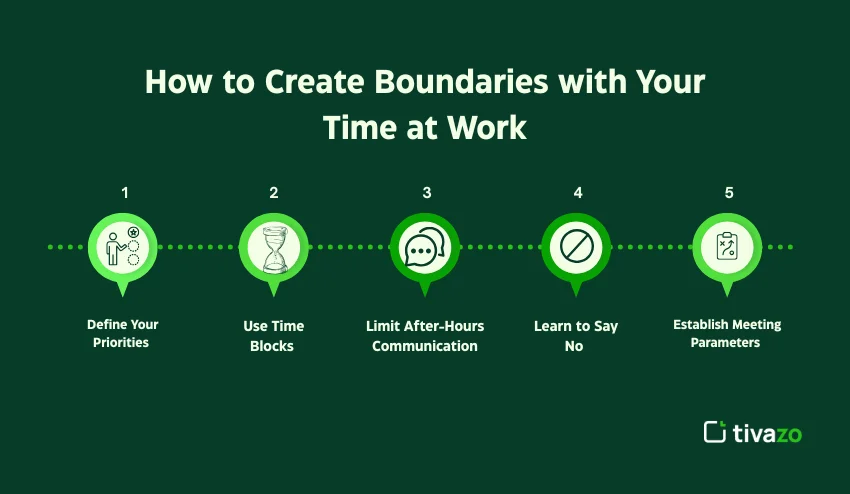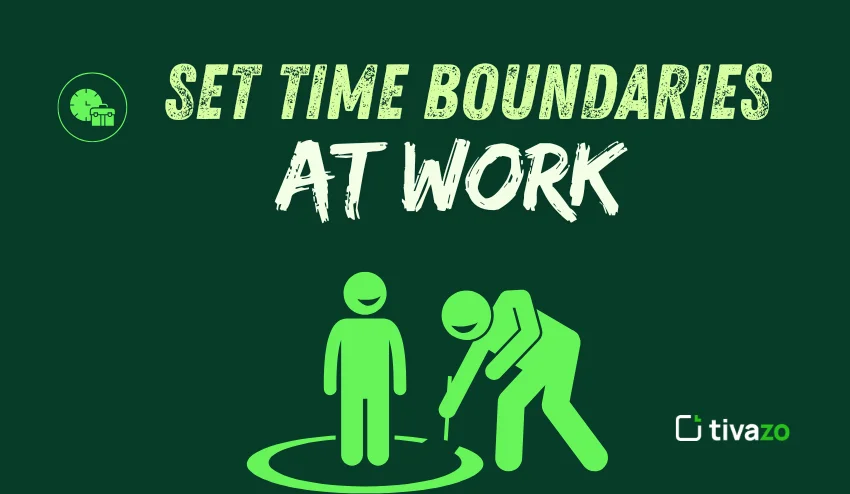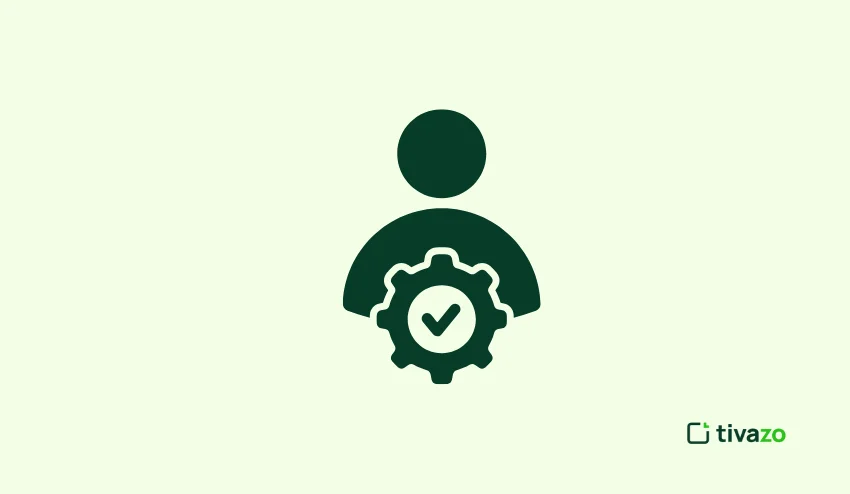Creating or to set time boundaries at work is one of the best ways to sustain Positive mental health, sustain productivity, and cultivate a good work-life balance. In today’s rapid-paced workplace culture, many people get overwhelmed with ongoing tasks, meetings back-to-back, and pressure to always be “on.” With the skill of creating time boundaries at work, employees can manage their schedules more mindfully, reduce stress, and orchestrate a better way to proceed with their work.
Having identifiable limits lets you avoid burnout, manage the expectations of your colleagues, and regain some control of your professional experience. In this blog, we will discuss practical strategies to create time boundaries at work, explain the reasons for creating boundaries, and provide affordable and realistic strategies for employees and managers. Whether you want to improve your own productivity for personal reasons or just to improve the culture of time management in your workplace, learning to set time boundaries at work is a skill that can enhance well-being and sustainability in the work experience.
Why Setting Time Limits is Significant at Work
In professional life, time is one of the most finite resources. When there is nothing to set time boundaries at work:
- Employees are at a high risk of burnout. When employees are always available, work is non-stop with little rest or recuperation, and deadlines are unreasonably shortened, employees may feel overwhelmed and lethargic, and have mental and physical exhaustion. Employees need to learn to set time boundaries at work to prevent burnout and provide for work and relaxation, and sustained work breaks.
- Employee productivity declines. When there is an expectation to multitask or interrupt anything/any matter during work, employees will be less productive. When employees learn to set time boundaries at work, businesses can expect work to be done higher quality level and within reasonable time frames.
- Employee work-life-balance diminishes. If there are no clear time boundaries, your personal time will easily be taken over by work. After a certain time frame, being focused on self-care during evening hours, weekends, and personal time should matter.
- Stress and conflict increase. If it is unclear, complete boundaries surrounding time; this ambiguity could cause tension between team members. Clarity allows for clarity and respectful work.
- Employees will become more efficient and focused. With time boundaries, the value of time becomes important when employees maximize the time to stay on task, managing interruptions, boredom, and completing work goals.
- Team dynamics can be improved. When one person’s time is sympathetic toward the others involved in a project, as compared to a previous collaborating engagement, it generally goes more smoothly, and the team members can work together better when respecting time.

How to Create Boundaries with Your Time at Work
Try these practical steps to successfully create boundaries with your time to set time boundaries at work.
1. Define Your Priorities
Identify the most significant work you have to do. When you know what is truly important, it is easier to protect your time as well as concentrate on high-impact work. Establishing priorities is the first action you can take to create boundaries with your time at work.
2. Use Time Blocks
Designate specific time blocks for deep work, meetings, and breaks. Inform coworkers about the blocks they should respect, so they help you stay focused. Time blocking is one of the most important strategies I use to create boundaries with my time at work.
3. Limit After-Hours Communication
Turn off notifications when you are off the clock (unless there is an emergency). When you easily communicate when you are unreachable, this reinforces what you are trying to do to set time boundaries at work with your time.
4. Learn to Say No
Say no to work that does not fall under your role or expectations. Being able to say no is important for us all who are trying to establish boundaries with our time at work, without feeling guilty.
5. Establish Meeting Parameters
Try to limit or reduce unnecessary meetings and instead request email updates. Having these obstacles to availability reinforces what you are trying to do to create boundaries with your time at work, while trying to maintain high productivity levels.

The 4C’s of Work Boundaries
The 4C’s are a simple but effective framework to support employees and managers in establishing to set time boundaries at work. The principles provided will ensure boundaries are respected while maintaining professional relationships and productivity.
| C | Meaning | Application |
| Clarity | Be clear about your time limits. | Communicate your availability upfront and share work hours, so people know when you can be reached. Clarity is vital to setting time boundaries successfully at work |
| Consistency | Stick to your rules | Establishing exceptions to your boundaries makes them weaker. Consistent habits build toward your effort to establish time boundaries at work and respect among team members. |
| Communication | Communicate your needs in an appropriate way. | Use assertive but respectful wording when you’re communicating around your boundaries. Clear communication will allow everyone to be on the same page, while impacting your productivity or potential conflicts. |
| Confidence | Believe your decisions. | Don’t feel guilty about having to protect your time. Confidence is vital to being the boundary setter and providing a framework where it is okay to establish time boundaries at work for productivity and well-being. |
By practicing the 4C’s, employees can effectively manage workloads, build to set time boundaries at work or into culture, and reduce stress. Employers can also begin to address their time and energy, while modeling for their employees how to promote balance in productivity.

The Five Key Workplace Boundaries
Boundaries at work are not limited to time, although time is at the core of the boundaries. Effectively learning how to set time boundaries at work lays a foundation for establishing all other types of boundaries and creating a healthier work environment.
- Time Boundaries: Define in advance your working hours and your breaks. Make it clear when you are available to work to avoid burnout and fatigue.
- Task Boundaries: Define what tasks are within and outside your job description so that you are not given too much work and that you can also effectively place time boundaries at work.
- Emotional Boundaries: Decide how much personal energy you share and how much emotional responsibility you will take on that interferes with work.
- Communication Boundaries: Guide the amount of availability you have via e-mail, chat, or telephone. Governing your time in advance and setting expectations with your colleagues to respect your time must be established.
- Physical Boundaries: Respect your personal space and the comfort of your rest. What is your physical environment that will help you set time boundaries at work most effectively?
As you learn and apply these five boundaries, your employer, employees, and managers will be able to develop a work culture that is respectful, productive, and sustainable.
Instances of Boundary Violations in the Workplace
Boundary violations can lead to decreased productivity and morale at work. Some examples include:
- Anticipating staff to respond to emails late at night.
- Creating meetings at lunchtime or break times.
- Giving employees tasks outside of their position without their agreement.
- Sneaking around vacation or leave policies.
Recognizing these violations allows managers and employees time away from work without burnout and set time boundaries at work.
Common Challenges in Establishing Time Boundaries
What is the single biggest challenge for you to clearly set time boundaries at work with your colleagues or clients?
- Disappointing others.
- Pressure from leadership.
- Working remotely enables the blend of personal and professional time.
- Lack of organizational culture surrounding boundaries.
Are Boundaries at Work Really Okay?
Yes, set time boundaries at work is okay! In fact, it’s necessary. Establishing time boundaries at work is a fundamental practice that is key to your mental health, productivity, and job satisfaction. To set time boundaries at work is a powerful way to help employees manage workloads, avoid burnout, and maintain separation between work and personal life. Boundaries also invite respect from colleagues and create a culture where employees understand the meaning of time. Additionally, managers who support their teams in establishing time boundaries at work are creating a model for lower stress, better team cohesion, and enhanced performance.
Without boundaries, employees and managers may risk creating toxic environments of confusion, overwork, and low morale. You should understand that creating solid limits on your time use is not an indication of weakness; it’s a professional skill that gives you room to work smarter, stay focused, increase your well-being, and accomplish goals of organizational effectiveness.
How Managers Can Support Time Boundaries
Managers are key players in helping employees create work boundaries. Managers create an organizational culture that values focus, productivity, and mental well-being by actively supporting boundaries. Managers can:
- Set reasonable deadlines: Do not require assignments of your employees that would take them beyond their capabilities. Effective and realistic planning can ensure teams can set time boundaries at work without feeling like ‘too much’ work is being added to their capacity.
- Be respectful of employees’ personal time after hours: No emails, no phone calls, and no messages outside of the hours that a team has decided to be the ‘working time.’ If it can wait, let it wait. Instead of interrupting time for personal objectives, this can help model health in habits. Staff should be permitted to recharge for the next day.
- Modeling healthy time boundaries yourself: When the manager is engaging in healthy time boundaries of their own (ie, scheduling, taking breaks, honoring their own boundaries), the employees are likely to participate in the same decision-making readily.
How to Decline an Additional Task with Kindness
When someone asks you for additional work at the expense of your work-life balance:
- Recognize the request: “I appreciate you thinking of me and recognize that this is important.”
- Be direct about your boundaries: “I don’t have the capacity for that today, but I can support you next week.”
- Provide options: Delegation (to someone else), reprioritization of deliverables (to the next day or later in the week), or breaking work into feat-able chunks can be good alternatives.
Using these strategies puts you on a path to set time boundaries at work with great confidence! Demonstrating professionalism, contributing to a productive environment, and embracing courteous and firm boundaries – all contribute to a respectful and healthy workplace. The more someone uses these approaches, the more trust develops in the team, and the more efficient you will become as a team.
Encouraging their employees to say no to other assignments: If staff are clearly overloaded, managers should advise the staff that it is acceptable to say no to extra assignments or request assistance completing assignments. Maintaining the work focus is important for maintaining the staff and for preventing burnout.
Strict vs Flexible Time Boundaries: Which Works Best?
Do you believe strict to set time boundaries at work that help to increase productivity or create rigidity?
- Strict Boundaries: Helps organize and ensure consistency, and enables employees not to overwork. Employees who have some rigid boundaries are better able to create time boundaries when working, finish work faster, and be deliberately engaged in adding to work-life balance.
- Flexible Boundaries: It helps to reduce rigidity in some urgent projects or unexpected changes. Flexibility allows deadlines to be met without compromising quality or collaboration.
Sometimes, the best of both strategies works: Agreed firm rules for day-to-day topics, but leave room for flexibility for one-off moments and/or unique situations. To create an interactive culture where employee and manager engagement, you must create cultures in which an organization encourages employees to create flexible boundaries, as well as rigid boundaries. We can create engagement, high productivity, and metrics of absence where stress and the Covidmatic engage professionally while celebrating one another, friends, and family, to set time boundaries at work.

Practical Suggestions for Establishing Time Boundaries in the Workplace
Take advantage of tools like Google Calendar, Trello, or time tracking applications to block time off for focused work.
- Avoid simultaneous tasks and focus your attention on one task at a time for quality, and it lessens the stress of multitasking.
- Schedule time off for breaks to rest and refresh your mind for the next task or activity. Scheduled breaks can avoid decision fatigue so that you conserve energy throughout the day.
- State your boundaries for colleagues to see in a time or hybrid environment, either in an email, update your status in Slack, or in a team meeting as much as appropriate for avoiding disruption to one another’s work time.
- Revisit boundaries meaningfully enough to change boundary barriers for getting work as being appropriate for sustaining productivity.
By taking a methodical approach combining overall focus and flexible approach, employees can create a pathway to confidently have to have set time boundaries at work to meet work/at-work demands, productivity, and provide a buffer for mental health, or overall well-being.
Conclusion
Set time boundaries at work is essential to developing productivity, focus, and a healthy work-life balance. Employees can sustainably navigate their work responsibilities and, ultimately, safeguard their well-being from suffering burnout by being clear about their priorities, time chunking, saying no, and minimizing work-related communication outside of the workday. One simple framework to support set time boundaries at work where the 4C’s (Clarity, Consistency, Communication, and Confidence) framework, while the five different boundary limits (time, task, emotional, communication, or physical) can help employees recognize and understand the limits that exist in the workplace environment.
Managers have a unique opportunity to model behaviors that promote a healthy habit, respect time limits, and encourage their employees to feel confident in communicating and asserting their boundaries. Employees can practice a hybrid of hard and soft set time boundaries at work to get their obligations and tasks completed effectively and efficiently, and still create flexibility. While it takes practice, these concepts can help employees to create or set time boundaries at work, lower their stress levels, and create a sustainable, productive, and respectful workplace environment all at the same time.




